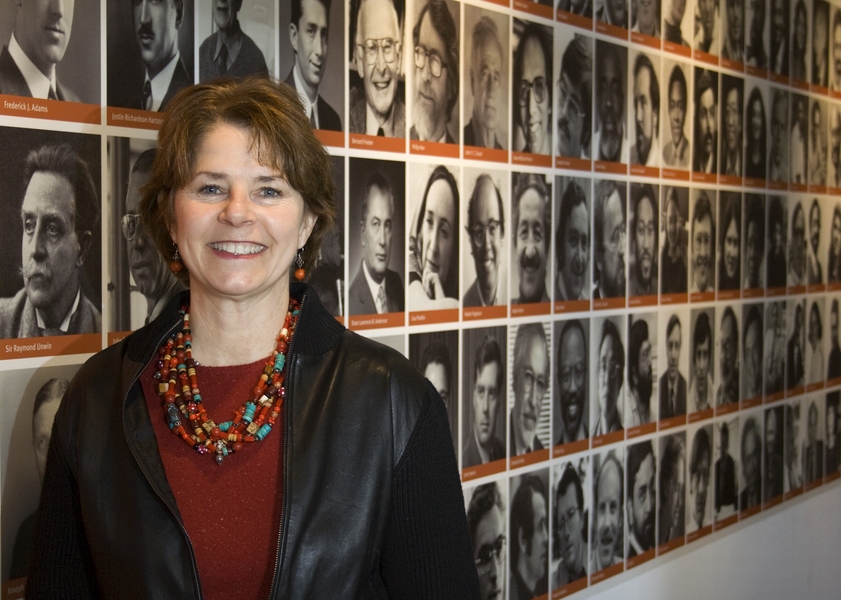If you type the phrase “living wage” into Google’s search engine, the first result that appears — even before the Wikipedia entry — is MIT’s Living Wage Calculator (LWC). Created by Amy Glasmeier, a professor of economic geography and regional planning at the School of Architecture and Planning, the LWC calculates the baseline wage employees need to earn to support themselves in any county in the United States. The online tool factors in costs including food, housing, transportation, medical care, child care, and taxes.
While Glasmeier has made minimal revisions to the LWC since she launched it in 2003 — in part to maintain its prominence in Google rankings — she has dramatically expanded its use, enlisting corporate, municipal, and civic partners who share her conviction and commitment to promoting a living wage. Some partners are ethically minded technology companies that lend expertise. Others are large nonprofits that use the LWC to help shape policy. Still others are corporations — including Ikea and Patagonia — that want to ensure that their employees can thrive on their salaries. A select few are partners that have contributed to the annual updating of the tool.
“There were several organizations that had been using our data,” explains Glasmeier, who built the LWC with the support of a Ford Foundation grant. “They all seemed to care deeply about the issue, so it was natural for me to invite them to be partners. It’s an interesting group of individuals and organizations who believe that corporations can build a living wage into their business models and still be successful.”
The U.S. was just emerging from a recession when Glasmeier began to work on the LWC. Rural areas had been hit particularly hard; residents of towns with one or two large employers lost their livelihoods when those employers failed.
“The LWC was never intended to be a high-wage or middle-class income-based tool,” explains Glasmeier. “It was created to show policymakers what happens when a big employer goes under. That knowledge encouraged them to formulate programs to ease the consequences of massive layoffs and plant closures.”
Today the idea of a living wage has gained momentum across a country where the gap between rich and poor widens from week to week. The LWC receives 100,000 hits per month. In 2014, it drew national attention when IKEA publicly adopted the tool to set wages in its U.S. facilities.
“They told me they chose the LWC because it was durable,” Glasmeier recalls. “And since it came from MIT, they figured it was calculated correctly.”
For Ikea, it was a natural fit.
“We believe if we want our co-workers to stay and grow with Ikea, we need to demonstrate our commitment to our co-workers through meaningful investments in compensation and benefits,” says Kenya Jacobs, Ikea's U.S. compensation manager. “The Living Wage Calculator has helped us estimate the appropriate wage needed to meet a person’s basic needs including food, housing, and transportation.”
Scott Woods is president of LWC partner West Arete, the Pennsylvania-based company wrote the software that runs LWC and was assigned the difficult task of aggregating multiple data sources on a county-by-county basis to make the calculator work. West Arete, which is certified as a B Corporation and is a member of 1% for the Planet (a nonprofit that directs corporate contributions toward environmental concerns), was drawn to LWC by its methodology and its mission, Woods says.
“The project is meaningful because of the impact it can have,” says Woods, whose company writes software for higher education. “We saw thousands of Ikea workers get raises overnight — and workers at other companies as well. And it’s hard to imagine anyone doing a better or more accurate job at this than Amy has. I don’t know where you’d go for better data.”
Carey Anne Nadeau ’15, CEO and founder of LWC partner Open Data Nation, believes that good policy requires good data, and that the LWC provides that data regarding a living wage.
“Without an expertise in data, we can’t make precise assumptions about what can and cannot be done,” says Nadeau, who earned a master’s degree in city planning at MIT. Her company uses data collection and analysis to help municipalities and, more recently, insurance companies make evidence-based proactive decisions. “With this tool we can fill the void, and effectively advocate for folks who have to work more hours than there are in a day and still can’t pay their bills.”
Early this year, Patagonia entered into a partnership with LWC. The outdoor and recreation company had been using LWC data for several years, and Glasmeier had visited corporate headquarters to speak with its human resource department about the labor market.
“Most companies in our position want to pay a competitive market wage,” says Jasin Nazim, a senior compensation analyst at Patagonia. “They base that wage on an industry survey. But it’s much more complicated to get data for a living wage in a company with employees in multiple cities. With the MIT Living Wage Calculator, I know I’m being as fair to my employees in Austin, Texas, as I am to those in San Francisco. And my employees can trust the numbers, because they’re coming from a third party, and that third party is MIT.”
At Just Capital, a New York–based nonprofit that advises companies and investors on important social issues, the LWC fell right in their wheelhouse.
“The living wage was one of the most important issues that emerged from our most recent survey,” says Andrew Stevenson, managing director for thematic research at Just Capital, whose board of directors includes Ariana Huffington and Deepak Chopra. “And Dr. Glasmeier’s work is well known and respected. We approached her to help draft policy for public service employees. It is a great way for us to partner with MIT on something that truly matters.”
For some LWC partners, joining a community of advocates was just as important as sharing critical data.
“We decided to partner with LWC because of the quality of the brand,” says Maurice Jones, president and CEO of The Local Initiatives Support Council. LISC is a nonprofit community development institution active in dozens of urban and rural areas. “Both MIT and LWC are a guarantee of quality. In addition, this partnership puts us in touch with a network of people who are committed to paying their employees a living wage. It’s a movement that is expanding, and that we want to be part of.”
The LWC has enabled MIT to develop robust and vibrant relationships with LWC partners. “Ikea and MIT understand that both the employer and employees win when businesses choose to pay their employees a living wage,” says Ikea’s Jacobs. “In addition, MIT provides research on Ikea’s behalf that is unique to our business model. This has enabled Ikea to maintain a sustainable living wage model.”
But there is still much work to be done. As of 2017, a typical family of four (two working adults, two children) needs to work nearly four full-time minimum-wage jobs (a 76-hour work week per working adult) to earn a living wage. Single-parent families need to work almost twice as hard as families with two working adults to earn the living wage. A single mother with two children earning the federal minimum wage of $7.25 per hour needs to work 138 hours per week — nearly the equivalent of working 24 hours per day for 6 days — to earn a living wage.
“It’s no longer a moral issue,” says Glasmeier. “More and more people are understanding that the current system just isn’t going to work. We need to allow people to live and work without going into debt. And we need to educate companies to think of a living wage as a fixed cost, and to economize on other budget items. Once they understand they can pay their employees a living wage and still be profitable, they’ll want to do it.”










